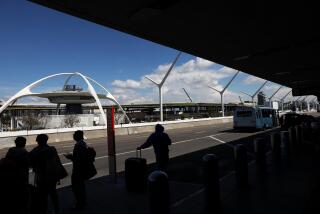Marines to Install Palm Springs Airport Radar System
The Marine Corps has agreed to install a battlefield radar system as a temporary solution to air traffic control problems at Palm Springs International Airport, where the faulty radar system has been shut down since Dec. 19, the Federal Aviation Administration announced Friday.
“The Marines have landed,” said Curtis Warren, local representative of the National Air Traffic Controllers Assn., which has complained about dangers posed by the lack of radar.
Marine technicians were at the airport Friday to prepare for the installation of a mobile radar unit of the kind used during Operation Desert Storm. The unit, the size of two cargo containers, will come from the Miramar Marine Corps Air Station in San Diego.
The FAA, meanwhile, is still hoping to revive the airport’s radar by installing a more powerful beacon and a backup system using long-range radar data from the Los Angeles Air Route Traffic Control Center. That system could require weeks to become operational and for controllers to be trained in its use.
“The FAA will not compromise safety,” said William Withycombe, FAA Western-Pacific regional administrator. “We will continue to expend FAA resources in our attempt to resolve the issue with the primary radar system.”
But Warren said the need to ask for help from the Marine Corps is a tacit acknowledgment by the FAA that it ignored the problems at Palm Springs until a crisis occurred.
“This is another chewing gum and baling-wire fix,” Warren said. “What we need is something that will provide a safe, reliable, permanent radar system. We need someone to say that this airport deserves a state-of-the-art system.”
The FAA has blamed the radar system’s problems on interference due to the region’s mountainous terrain, weather and wind turbines. The Marine Corps radar is designed to overcome such factors and be installed quickly.
Without radar, the airport’s 26 air traffic controllers have relied on sight and radio communication for planes flying beneath 8,000 feet and are keeping those aircraft separated by 30 miles. The result has been delays, much to the annoyance of travelers coming to the desert for the holidays.
Traffic controllers have reported several close calls as planes came within hundreds of feet of each other. The airport handles about 100,000 takeoffs and landings per year.
A 25-person FAA technical team spent eight days examining the radar before deciding that it could not be fixed immediately. After becoming frustrated at what they felt was inaction by the FAA, the controllers went public last week with their concerns about public safety.
Radar was installed at the airport in 1979.
More to Read
Sign up for Essential California
The most important California stories and recommendations in your inbox every morning.
You may occasionally receive promotional content from the Los Angeles Times.










